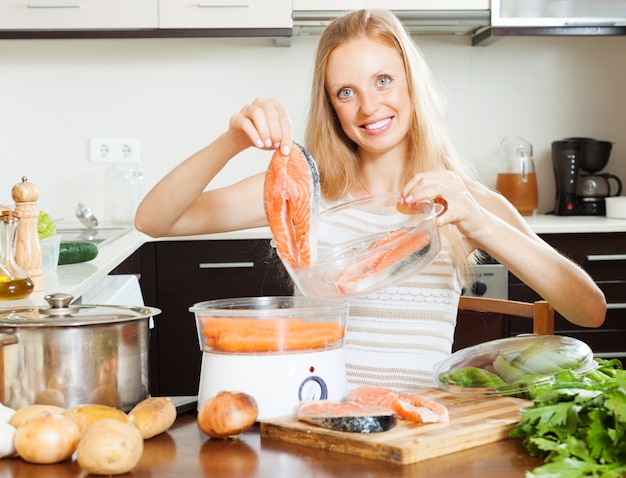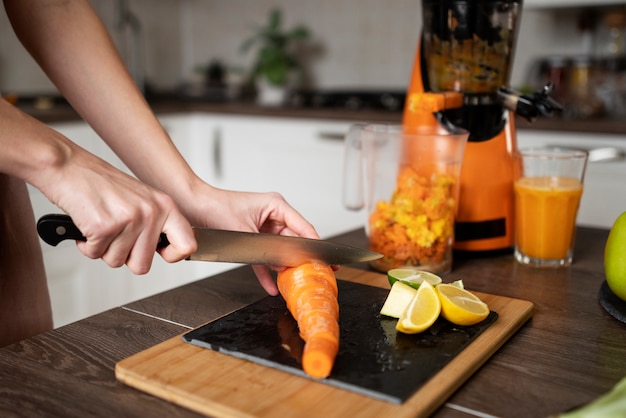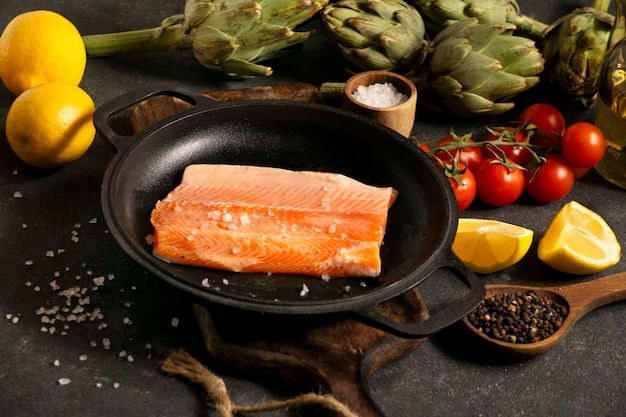Okay, let's talk salmon! It's a real crowd-pleaser, isn't it? I've been cooking it for years, and it never fails to impress. From sizzling it on the grill to baking it in the oven, salmon always hits the spot. But here's the thing: getting the cooking time right is absolutely crucial. You don't want to end up with dry, disappointing fish, or, even worse, a salmon that's still raw in the middle! I've had my fair share of salmon mishaps in the past, but I've learned a few tricks along the way. So, let's dive in and figure out how to nail those perfect cooking times for baking, grilling, and pan-frying salmon!
(Part 1) Understanding Salmon: A Delicate Fish

Why Time Matters
Before we get into the nitty-gritty of cooking times, it's important to understand why salmon is a bit of a finicky fish when it comes to cooking. Salmon has a delicate texture and a fairly low fat content. This means it can dry out quickly if overcooked. You want that beautiful, pink flesh to be moist and flaky, not dry and tough.
The Importance of Thickness
The thickness of your salmon fillet is the biggest factor in determining cooking time. Thicker fillets need longer to cook through than thinner ones. This is because heat takes longer to penetrate a larger piece of fish.
Cooking Temperatures: High Heat or Low and Slow?
The cooking temperature also plays a part. If you're grilling or pan-frying, you'll be using a higher temperature, which cooks the salmon faster. When baking, you'll generally use a lower temperature, which gives you a more even cook.
(Part 2) baking salmon: The Oven's Delight

Preheating is Essential
Let's start with baking, my go-to method for a foolproof salmon dinner. First things first: make sure your oven is preheated to the correct temperature. This helps ensure the salmon cooks evenly and doesn't dry out. It's like starting your car engine; you need to get things warmed up before you start cooking!
Baking Time Guidelines
Here's a general guideline for baking salmon based on its thickness:
| salmon thickness | Baking Temperature | Baking Time |
|---|---|---|
| ?? inch | 375°F (190°C) | 12-15 minutes |
| 1 inch | 375°F (190°C) | 15-20 minutes |
| 1 ?? inch | 375°F (190°C) | 20-25 minutes |
The "Flake Test": Your cooking guide
The best way to know if your salmon is cooked through is the "flake test." Gently use a fork to test the thickest part of the fillet. If the salmon flakes easily, it's ready. If it's still a bit resistant, give it a few more minutes. Don't overcook it!
(Part 3) Grilling Salmon: The Outdoor Feast

Get That Grill Going
Ah, grilling! It's the perfect way to enjoy a summer evening. But before you throw your salmon on the grill, make sure it's heated to medium-high. You want those lovely grill marks, but not burnt salmon!
Grilling Time Guidelines
Here's a general guideline for grilling salmon:
| Salmon Thickness | Grilling Time per Side |
|---|---|
| ?? inch | 4-6 minutes |
| 1 inch | 6-8 minutes |
| 1 ?? inch | 8-10 minutes |
Don't Overcook: It's All About Timing
Remember, grilling is all about high heat and quick cooking. Don't overcook the salmon. It should be cooked through but still moist and flaky.
(Part 4) Pan-Frying Salmon: The Quick and Easy Choice
Fast and Flavorful
Pan-frying is another fantastic way to cook salmon, especially for those nights when you want a quick and easy meal.
Get That Pan Hot!
Just like grilling, you want to heat your pan over medium-high heat. Add a tablespoon or two of olive oil or butter, and let it get nice and hot before adding the salmon.
Pan-Frying Time Guidelines
Here's a general guideline for pan-frying salmon:
| Salmon Thickness | Pan-Frying Time per Side |
|---|---|
| ?? inch | 3-4 minutes |
| 1 inch | 4-5 minutes |
| 1 ?? inch | 5-6 minutes |
Watch for Those White Edges
When pan-frying, keep a close eye on the edges of the salmon. They'll start to turn white and the flesh will start to flake. That's your cue to flip it over and cook the other side.
(Part 5) Beyond the Basics: Adding Flavor and Finesse
Skin On or Skin Off?
There's always a debate about whether to cook salmon with the skin on or off. Personally, I prefer skin-on salmon. The skin adds a nice bit of flavor and texture, and it helps keep the flesh moist. But it's really up to your personal preference.
Marinades and Seasonings: A Flavor Explosion!
A little bit of seasoning can go a long way! You can marinate your salmon in anything from lemon juice and herbs to soy sauce and ginger. I love a simple marinade of olive oil, lemon juice, salt, and pepper.
Get Creative: Experiment with Different Methods
Don't be afraid to experiment with different cooking methods and flavors. Salmon is a very versatile fish, so there are endless possibilities!
(Part 6) Salmon cooking tips: Avoiding Common Mistakes
Avoid Overcrowding: Give Salmon Some Space
When baking, grilling, or pan-frying, avoid overcrowding the pan. This will lead to uneven cooking. Give the salmon some space to breathe.
Don't Press Down: Let It Cook Naturally
When you're cooking salmon, resist the urge to press down on it with a spatula. This will force out the juices and dry out the fish. Let it cook naturally.
Rest Before Serving: Let the Juices Settle
After cooking, let the salmon rest for a few minutes before serving. This allows the juices to redistribute, resulting in a juicier and more flavorful fish.
(Part 7) Recognizing overcooked salmon: Signs to Watch Out For
Don't Overdo It!
Remember, overcooked salmon is a tragedy. You want it to be cooked through but still moist and flaky.
Signs of Overcooked Salmon:
Dry and Tough: The flesh will be dry and tough.
Dull Gray Color: The color will be a dull gray, rather than a vibrant pink.
Curling Edges: The edges may start to curl.
Don't Panic: There's Still Hope!
If you've overcooked your salmon, don't panic. There are still ways to salvage it. Try using it in a salad or a sandwich.
(Part 8) Serving Salmon with Style
The Perfect side dishes: Complementary Flavors
Salmon is a wonderfully versatile dish that pairs well with a variety of side dishes.
- Roasted vegetables: Think roasted asparagus, Brussels sprouts, or sweet potatoes.
- rice pilaf: A light and fluffy rice dish adds a contrasting texture to the salmon.
- Green salad: A crisp salad provides a refreshing element to your meal.
- Couscous: Couscous is a great option for a light and flavorful side.
- Pasta: A simple pasta dish, like spaghetti with marinara sauce, complements the salmon nicely.
Dress It Up: Finishing Touches
A simple dollop of sour cream or Greek yogurt can really elevate your salmon dish. And don't forget a squeeze of lemon juice for a bright and tangy touch!
(Part 9) FAQs: Your Salmon Questions Answered
Q: How can I tell if my salmon is cooked through?
A: The best way to check is the "flake test." Gently use a fork to test the thickest part of the fillet. If the salmon flakes easily, it's ready.
Q: What happens if I overcook salmon?
A: Overcooked salmon will be dry and tough. The flesh will be a dull gray, rather than a vibrant pink.
Q: What's the best way to prevent salmon from sticking to the pan?
A: Make sure the pan is hot enough before adding the salmon. Add a tablespoon or two of olive oil or butter to the pan.
Q: Can I freeze salmon?
A: Yes, you can freeze salmon. Wrap it tightly in plastic wrap and aluminum foil. It will keep in the freezer for up to 3 months.
Q: How do I thaw frozen salmon?
A: Thaw frozen salmon in the refrigerator overnight. You can also thaw it in cold water, but make sure to change the water every 30 minutes.
I hope this guide has been helpful. Remember, cooking salmon is all about understanding the basics, mastering the timing, and being comfortable with experimenting. So, next time you're craving salmon, don't hesitate to grab your favorite recipe, fire up the grill, or heat up your oven. Your taste buds will thank you!
Everyone is watching

How to Cook Frozen Lobster Tails Perfectly: A Step-by-Step Guide
RecipesLobster. Just the word conjures up images of lavish meals, special occasions, and a taste of luxury. But let's...

Pork Fillet Cooking Time: How Long to Cook It Perfectly
RecipesPork fillet, or tenderloin as it's sometimes called, is a real favourite in our house. It's so versatile, and...

Pigs in a Blanket Cooking Time: How Long to Bake for Perfect Results
RecipesAh, pigs in a blanket. Just the name conjures up images of those delightful little parcels of crispy pastry en...

The Ultimate Guide to Cooking Delicious Frankfurters
RecipesLet's face it, we all love a good frankfurter. It's a classic, simple, and always satisfying. But let's be rea...

Wolf Meat Recipes: A Guide to Cooking Wild Game
RecipesLet's be honest, you don't see wolf meat at your local butcher shop every day. It's a bit of a wild card, but ...
